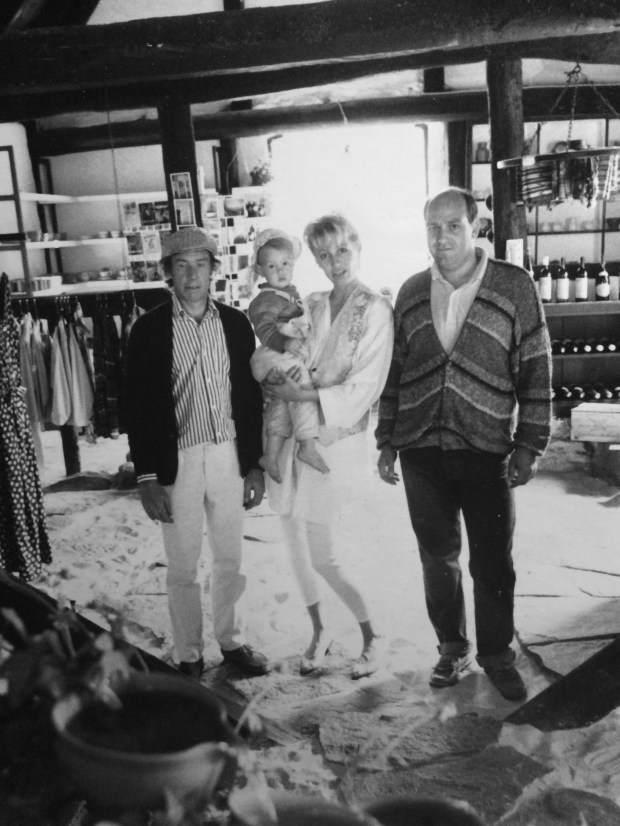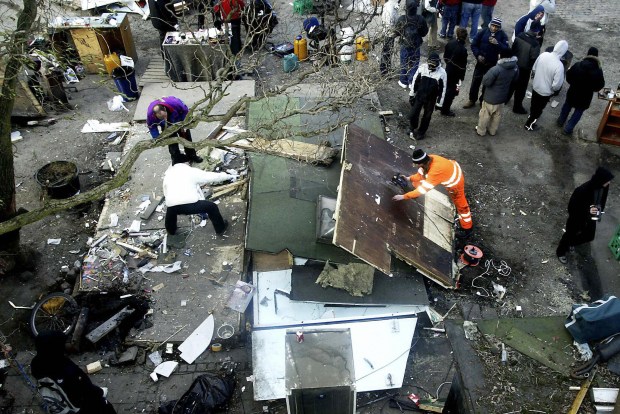If you look at the list of Denmark’s most popular tourist attractions, you’ll find the expected number of royal castles, centuries-old amusement parks and, of course, Legoland. There’s one alternative surprise near the top of the list, though: the “freetown” of Christiania.
Everything about Christiania defies logic—and, quite often, laws. It’s a hippie commune in the heart of Copenhagen, nestled between the city’s most expensive neighborhoods. The houses, built by the owners, are more creatively constructed than the most daring tree house, yet many of them have stood their ground for decades. And hash is sold openly on Pusher Street, often by armed members of organized crime gangs, though hashish is illegal in Denmark, and weapons are as illegal in Christiania as in the rest of the country. Yet the community has survived, and last year it celebrated its 45th anniversary.
The Danes either love or hate Christiania, and they do so with vigor. Many Christianites consider it their beloved home country. For those of us who didn’t grow up in Christiania but in its shadow, it’s a little more complicated.
Christiania was founded in 1971 when a group of young people broke into an abandoned military base. They started a social experiment where hippies, artists, and the homeless lived together in a semi-autonomous community governed by its inhabitants. My parents were some of the early Christianites. They met through common friends, all from Christiania, but decided to move to an island in the Baltic Sea to live closer to nature and their many friends from the freetown who’d already made the move. I didn’t grow up in Christiania, but in a kind of Christiania-colony on the island of Bornholm a three-hour boat ride away.

Though my parents intended to stay on Bornholm, it didn’t work out that way—Christiania has a way of pulling you back. It’s where my dad sought shelter and got back on his feet after my parents’ divorce. It’s where I went when I moved away from home at 16, paying rent with the tips I made at one of the freetown’s alternative music venues. It’s where my sister found one of her first rooms when she left the island. And it’s where my mother stayed this fall, housesitting for a friend who’s away on a month-long yoga retreat.
When I visited my mother in her new, temporary home for the first time, Christiania was dealing with the aftermath of a shooting. Just before the commune’s 45th birthday, a 25-year-old man with connections to the hash market had fired gunshots. He’d injured three people; one was a police officer. Half of the commune’s adult residents met up that night to discuss the event, which the commune’s spokesperson Hulda Mader called “a wake-up call for all of Christiania.” For decades the hash dealing had become more organized, criminal, and disconnected from the unwritten and frequently debated philosophy of the place; many claimed it had been taken over by Hells Angels.
The dealers on the aptly-named Pusher Street wore masks, and the stalls were covered in military camouflage nets. It seemed more like a war zone than a commune. After the shooting, residents decided to tear down the stalls. For the next few days national and international media covered the demolition; the last time a journalist had turned on a video camera in the area he’d been beaten up, stripped, and chased naked out of the freetown by the dealers.

For a few weeks after the stalls were torn down it seemed as if things had changed. Christianites were having community dinners in the street, there was talk of erecting a fountain, and locals were planning events and markets selling more innocuous products. When I walked down Pusher Street a month later, however, the honeymoon was over. Many of the stalls were back, though they were less covered, and visitors were buying hash before heading to cafés such as Nemoland and Månefiskeren, where the air is thick with sickeningly sweet smoke.
But as always, I was reminded of how many reasons there are to love Christiania as soon as I passed the street. To a few, Christiania is only a place to buy hash; to the commune’s 850 or so inhabitants, it’s a lot more than that.
At the women’s smithy, a team of badass ladies produces beautiful furniture and fixes damaged windows, stairs, and furniture. Opposite, you’ll find the bicycle shop that invented the Christiania bike, a three-wheeled cargo set-up popular with families all over Denmark. The jazz club Børneteatret—the Children’s Theatre—is a popular place for late-night jam sessions, especially on the nights when students from the nearby conservatory pop in. The Grey Hall is the meeting space for the community’s joint meetings; Christiania is governed by a consensus mechanism, resulting in marathon meetings and, sometimes, good decisions.
It’s also home to the yearly Christmas dinners for the homeless and anyone else who’d like to join—usually several hundred people—and to concerts, fashion shows, and parties. And then there’s the kindergarten, the public bathing house, and sauna, the initiatives to make Christiania more sustainable, the vegetarian cafés, and the general sense of community.

I passed the small, wooden bridge that connects downtown Christiania to the more rural parts of the commune. While the downtown area is a jumble of music venues, bars, cafés, stores, and old brick buildings, the rural part is home to small houses built on the lake. From the bridge you can see a wide range of the avant-garde houses; Christiania consists of 325 houses, 104 of which are former military buildings. The remaining 221 houses were built by the people who live there.
Cabins have been given second floors and winter gardens, some houses appear to be floating on the lake, a few are made entirely out of windows, and a handful are constructed so improbably that it’s a wonder gravity hasn’t sent them toppling. I continued walking to the very end; my mother was spending the winter in one of the last houses of Christiania, just opposite the ground where the new Noma is being constructed for its reopening later this year. When I got to her house I’d forgotten all about Pusher Street; I’d fallen in love with the rest of the place all over again.
A few months later we celebrated Christmas in Christiania. Just before the Christmas dinner on the evening of December 24, my sister and I paid a visit to one of the families we’d grown up with on Bornholm; they now split time like we do, between the island and Christiania. They were setting up the giant table and decorating an even bigger Christmas tree; their holiday would take place in a high-ceilinged commune with two dozen inhabitants, ranging from babies to pensioners. We exchanged presents and cookies and marveled at the tree and then my sister and I headed back, through the freetown and over the bridge.
”It’s such a Bethlehem sky,” my sister said, perhaps inspired by the hymns we’d been humming all day.
We stopped for a second to look up at the bright blue starry sky. The falling darkness was turning the spire of the legendary church at the entrance of Christiania into a somber silhouette. All was quiet; people were celebrating at home or had already gone to the Christmas party at The Grey Hall.
”Yes,” I said, squeezing her hand. ”It certainly is a holy place to some.”